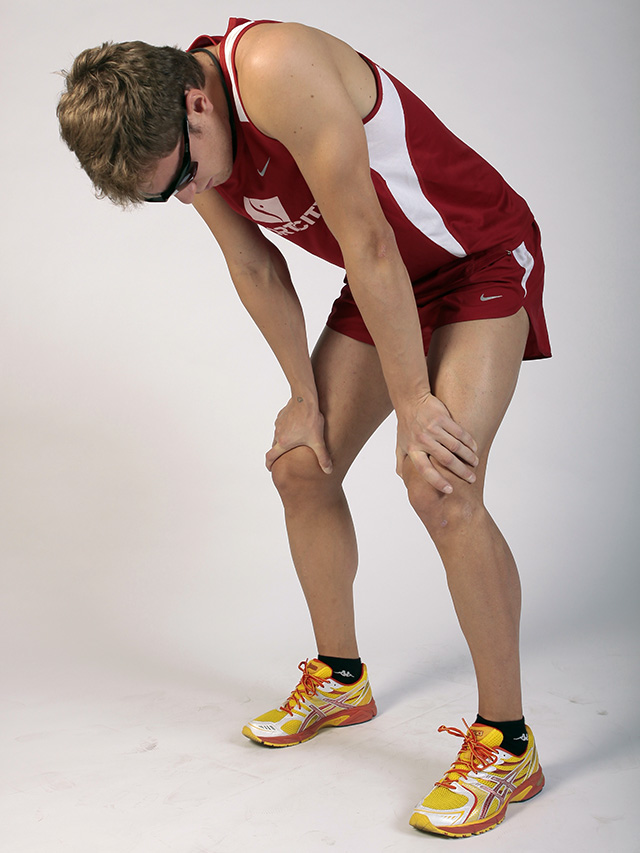Fatigue is commonly classified as either central (proximal to the motor neurones) or peripheral (within the motor unit) in origin. Although central nervous system fatigue may well play a part in muscle fatigue, at least a substantial component can always be found in the muscle (Vollestad & Sejersted, 1988). This discussion of fatigue will therefore be limited to fatigue mechanisms within the motor neuron and muscle cell system.
 exhaustion occurs when the required force or exercise intensity cannot be maintained
exhaustion occurs when the required force or exercise intensity cannot be maintainedThe several steps involved in the propagation of the action potential to the subsequent activation of the contractile elements, have been implicated as potential sites of fatigue. These steps include membrane excitation and action potential propagation, calcium release from and re-uptake by the sarcoplasmic reticulum, actin-myosin interaction, and metabolic energy (ATP) supply (Hargreaves, 1991)
Mechanism of Fatigue
Muscle fatigue, which is the gradual decrease in force generating capacity, is distinct from exhaustion, which occurs when the required force or exercise intensity cannot be maintained (Vollestad & Sejersted, 1988). Muscle fatigue is generally due to the depletion of energy stores and the accumulation of lactic acid within the muscle cells (Schmidt & Thews, 1983). The mechanisms of fatigue during intense anaerobic exercise are poorly understood, and despite extensive research, have yet to be clearly defined (McArdle et al., 1991). This is probably due to muscle fatigue being a complex phenomenon with numerous possible sites of origin. The most important or rate limiting steps are unknown (Jones, 1980; Tesch, 1980).
Most researchers view the fall in intramuscular pH as the primary cause of muscle fatigue during intense exercise. Almost every cellular process is sensitive to changes in pH (Boron, 1989). Consequently if the cellular pH deviates from the optimal range for the function of enzyme systems, there are pronounced changes in metabolism. The optimal pH of many cellular proteins is at or around normal resting pH (e.g., 7.0), and therefore a fall in pH during exercise, due to build-up of lactic acid (HLa), could alter the activity of many proteins. With reference to muscle fatigue, the decreased intracellular pH has been found to inhibit many of the glycolytic enzymes, particularly phosphofructokinase (PFK). The enzyme PFK is the most important control element in glycolysis, and has been shown to be completely inhibited at a pH of 6.3-6.4 (Hermansen, 1981).
A decreased intramuscular pH can also cause fatigue by the inhibition of calcium (Ca2+) binding to the troponin-tropomyosin complex, the necessary step for muscle filament coupling and therefore force development (Fuchs et al., 1970). The release of Ca2+ from the sarcoplasmic reticulum is also inhibited by a decrease in intracellular pH (Fabiato & Fabiato, 1978). This would result in a decrease in the intracellular concentration of Ca2+, and therefore the amount of Ca2+ binding to the troponin-tropomyosin complex.
Although the rate limiting steps are unknown, there are potentially many sites that when inhibited cause fatigue. The decrease in cellular PH has been implicated as responsible for many of these. Therefore the mechanisms which control the pH of the muscle cells and the blood become important in regulating the fatigue process.
References
- Boron, W.F. 1989, 'Cellular buffering and intracellular pH', in: Seldin, D.W. and Giebish, G. (eds), The Regulation of Acid-Base Balance, Raven Press, NY, pp.33-56.
- Fuchs, F., Reddy, V. and Briggs, F.N. 1970, 'The interaction of cations with the calcium-binding site of troponin', Biochimica et Biophysica Acta, 221, pp.407-409.
- Hargreaves, M. 1991, 'Limits to performance: the muscle', in: Sutton, J.R. and Balnave, R. (eds), 'Cardiovascular & Respiratory Responses to Exercise in Health & Disease', Proceedings of the 8th Biennial Conference, pp.197-203.
- Hermansen, L. 1981, 'Muscular fatigue during maximal exercise of short duration', Medicine and Sport, 13, pp.45-52.
- Jones, N.L. 1980, 'Hydrogen ion balance during exercise', Clinical Science, 59, pp.85-91,
- McArdle, W.D., Katch, F.I. and Katch, V.L. 1991, Exercise Physiology - Energy. Nutrition and Human Performance, 3rd ed, Lea & Febiger, Philadelphia.
- Schmidt. R.F. and Thews. (eds) 1983, Human Physiology, Springer-Verlag, Heidelberg.
- Tesch, P. 1980, 'Muscle fatigue in man', Acta Physiologica Scandinavia (supplement 480), 109, pp.1-40.
- Vollestad, N.K. and Sejersted, O.M. 1988, 'Biochemical Correlates of fatigue. A brief overview', European Journal of Applied Physiology, 57, pp.336-347.
Related Pages
- Muscles List — some basic descriptions of some of the muscles of the human body.
- The difference between fast and slow twitch muscle fibers
- The Energy Systems Explained — a complex system explained well.
- A fitness test to estimate muscle fiber composition
- The Human Engine
- About Sports Medicine
Disclaimer


 Current Events
Current Events